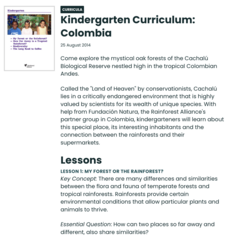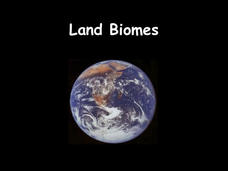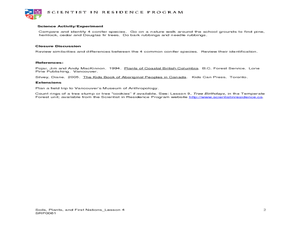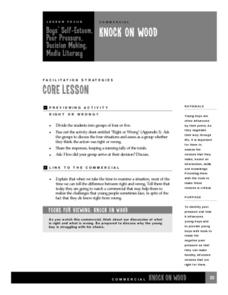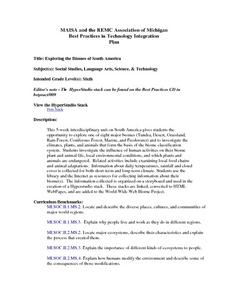Curated OER
Meet the Plants
Are you looking for a PowerPoint that identifies and explains the job each plant part performs? Perhaps you've found it! Examples of different types of plants, as well as common household items derived from plants are included. The text...
Biology Junction
Seed Plants: Gymnosperms and Angiosperms
One of the reasons plants found success on land relates to seed development. Scholars learn about many different forms of seeds and how they changed over time. It describes the structure and function of many different types of seeds in...
Curated OER
My Forest or the Rainforest?
Students explore the flora and fauna of temperate forests and rainforests. They examine the environmental conditions that allow certain plants and animals to live in the rainforest.
Curated OER
Fields, Meadows, and Hedgerows: Trees, Bushes, and Plants
For this trees, bushes, and plants worksheet, students gather facts and answer short answer questions about trees, bushes, and plants. Students complete 8 questions total.
Curated OER
Plants
In this plants worksheet, students review the alternation of generations in plants and the function of seeds and flowers for plants. This worksheet has 11 short answer questions and 4 fill in the blank questions.
Biology Junction
Plant Diversity
Ginkgo trees existed for more than 350 million years, and, at this time, only one species still remains. While plant diversity generally increases over geologic time, some interesting exceptions occur. Young scientists learn about plant...
Curated OER
Biomes
Arranged as an interactive lesson, this presentation focuses on the six world biomes. Upcoming biologists click on a specific biome and a slide lists its location, description, native plants, and animals. A quiz provides learners with...
Curated OER
Tree Identification/Tree Art
Seventh graders identify and examine a deciduous and coniferous tree. Using the descriptions, they discover the types of tress in their local area. As a class, they practice identifying trees on a walk in a park collecting leaves. They...
Biology Junction
Land Biomes
Biomes share similar climates and ecosystems, despite being separated geographically on the planet. A presentation introduces the six most common land biomes. It focuses on the commonalities in climate, plants, and animals with many...
Montana Natural History Center
Studying Grassland Ecosystems
At first glance, grassland ecosystems might seem dull and uninteresting, but once you start to explore it's amazing the things you'll find! Through this series of engaging lessons, activities, and experiments, elementary students examine...
Curated OER
Dichotomous Key for Identifying Pine Trees
Students identify the species of pine trees that are found in their area. They use unlabeled "mystery" samples and a dichotomous key to identify the pine trees to species. After identification, they use a field guide to answer worksheet...
Curated OER
Botanical Garden Field Trip
Students take a field trip to a botanical garden. In this habitat lesson, students walk through the garden and see various species of plants and animals. Students take a canopy walk and see coniferous trees. Students write about what...
Curated OER
Western Red Cedar
Learners explore the First Nations uses of the Western Cedar tree. In this nature lesson students compare and identify four conifer species. The learners go on a nature walk.
Curated OER
Knock On Wood
Students investigate the trees of the Mississippi Valley, specifically looking at the coniferous and deciduous forests. The research of the area is part of a field study when students conduct a survey of local forests in order to create...
Curated OER
Taiga
In this taiga worksheet, students read a short article describing what a taiga is and then answer 10 multiple choice, true or false or short answer questions relating to the article.
Curated OER
The Water Cycle: Transpiration
Young scholars identify and describe the stages in the water cycle. Using plants, they determine if they play a role in the cycle and measure the water the plants give off. They complete an experiment to determine if deciduous or...
Curated OER
Forests of the World
For this forests worksheet, students read a one page informational excerpt on different forests throughout the world. They then use what they learned to answer the 20 questions on the worksheet. The answers are on the last page of the...
Curated OER
Our Friends the Trees
Students explore trees and learn about their importance to the environment. In this tree study lesson, students work in groups to complete a tree survey, a map for the survey, and several worksheets about the tree topics. students make a...
Curated OER
Evergreen Trees & Softwood
In this earth science worksheet, students identify and locate various vocabulary terms pertaining to evergreen trees and other softwood trees. There are 26 earth science terms located in the word search.
Curated OER
The Prairie Climate
Ninth graders research the average temperature and precipitation of a prairie region to determine the type of climate it is, and how it differs from other biomes. They examine the types of adaptions animals have made to live in the...
Rainforest Alliance
My Forest or the Rainforest?
The differences between tropical and temperate rainforests range from animals and flowers to climate and landscapes. Kindergarteners compare and contrast characteristics of their local forest to a tropical rainforest.
University of Georgia
Land Biomes Project
Challenge scholars to research a biome and create a presentation for the producers of Survivor to choose their ecosystem for the next season's show. The materials include outlines, worksheets, and grading rubrics for individuals as well...
Curated OER
Exploring the Biomes of South America
Sixth graders complete a five-week unit investigating the eight major biomes of South America. They conduct Internet research, collect short-term and long-term climate data, and create a HyperStudio slideshow stack about a selected biome...
Curated OER
Habitats of the World
Students discover that the Earth supports many different animal habitats. In this habitat lesson students research different habitats of the world. Students show how the animals in their habitat are adapted.


